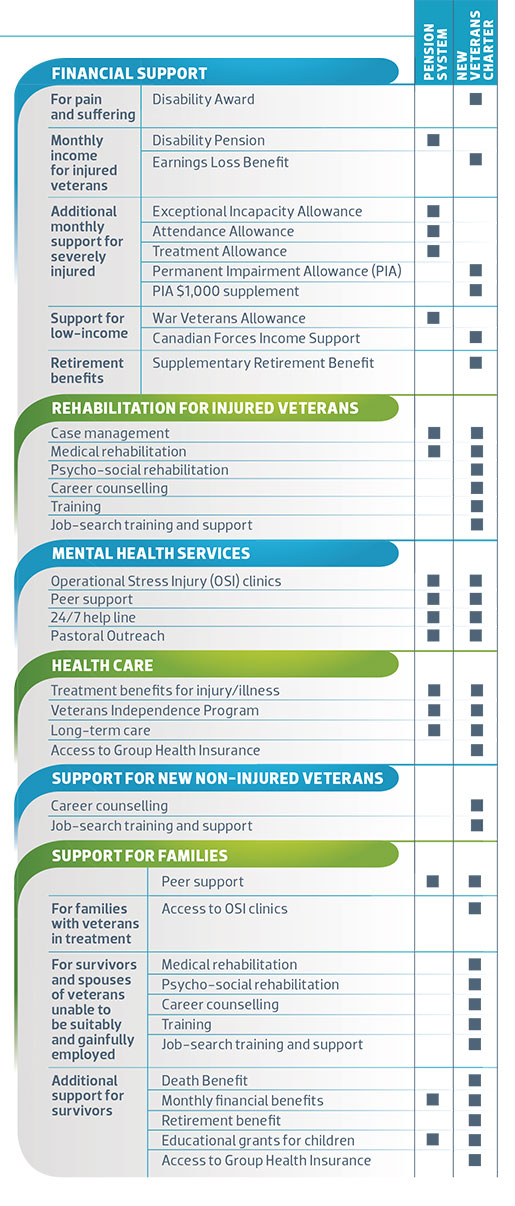Veterans And Their Families Are Divided On Veterans Services
By Ruth Davy, Ipsos Reid
A public opinion poll commissioned by Legion Magazine found that Canada’s veterans and their families are divided when it comes to pride in how Canada treats its veterans.
The poll found 41 per cent agree they are proud of how Canada treats its veterans, while 37 per cent disagree. On the effectiveness of the benefits and services provided by Veterans Affairs Canada, 39 per cent viewed them as effective, while 32 per cent view it as ineffective.
This is in stark contrast to almost half (47 per cent) of Canadians who neither agree nor disagree that they feel VAC’s benefits and services are effective and two in five (38 per cent) who neither agree nor disagree that they are proud of how Canada treats its veterans.
It would seem those with the most contact and familiarity with how Canada treats its veterans are polarized when it comes to these issues while the general public is just not aware. Over half of veterans and their families (54 per cent) are familiar with the programs and services offered by Veterans Affairs Canada, compared to just a quarter of Canadians in general (27 per cent).
While the majority of Canadians (83 per cent) agree that it is important to support members of the Canadian Armed Forces following their services, only one in three (34 per cent) are proud of how Canada currently treats its veterans, while two in five (42 per cent) are not sure. One in five Canadians (20 per cent) and almost half of veterans and their families (45 per cent) are familiar with the policies and programs related to assisting veterans with a disability. This would suggest strong support from the public for veterans programs but a general lack of familiarity and awareness of how Canada is doing in delivering this support.
While there is support for these programs, only two per cent of Canadians report that they are currently caring for someone who receives or is eligible to receive benefits from VAC, and only one in 10 (nine per cent) of veterans and their families report being in receipt of benefits from VAC.
Just over half (55 per cent) of veterans, their families or caregivers were satisfied or very satisfied with the health benefits offered by VAC. Between half and two in five (38 per cent) were unfamiliar with the programs and services offered including employment and career transition services (48 per cent), affordable housing (44 per cent), rehabilitation and treatment programs (39 per cent) and health benefits (27 per cent).
Two in five (38 per cent) were satisfied with the rehabilitation and treatment programs, and one in three (34 per cent) were satisfied with the employment and career transition services.
Most of those receiving services (63 per cent) had not the used the services of veterans organizations. Nineteen per cent had received assistance from VAC and 10 per cent had used the services of The Royal Canadian Legion.
Ipsos Reid was commissioned by Legion Magazine to conduct a survey among Canadians, aged 18 and over, regarding their attitudes towards the services offered to Canada’s veterans as a part of the Canadian Household Online Omnibus. The survey was conducted between Oct. 28 and Nov. 4, 2013, among a base of 1,067 Canadians. This included a sample of 123 veterans and family members caring for veterans. ♦
Click to download the Ipsos Reid Survey Results (PDF)
————————————————————————————————————————————
Changes With The New Veterans Charter
By Sharon Adams
April 1, 2006, is a dividing line for Veterans Affairs Canada disability benefits. Prior to that date, veterans of the Second World War or Korean War, merchant navy veterans and certain civilians who served in support capacities in wartime, current and former members of the Royal Canadian Mounted Police, and Canadian Armed Forces (CAF) members and veterans were all covered by the Pension Act.
The Pension Act governs disability pensions and treatment and support services for those with disabilities and health conditions caused or worsened by service. The amount of pension depends on the severity of the disability and how much of it is related to service and is assessed as percentage. There are also monetary allowances for those who need an attendant to help them; who require specially made clothing or have a condition that causes wear and tear on clothing; and for those who are exceptionally incapacitated. It also provides benefits for spouses and dependent children.
Since April 1, 2006, The Canadian Forces Members and Veterans Re-establishment and Compensation Act (the New Veterans Charter) has covered CAF members and veterans who served after April 1, 1947 (except in the Korean War) and their survivors. The New Veterans Charter provides compensation for loss of income and non-economic factors such as pain and suffering as well as programs to ease transition to civilian life. The disability award may be paid as a lump sum, annual payments or combination of the two. The amount of the disability award is determined by the severity of the disability and how much of it is related to service. The charter also provides support programs, including rehabilitation services, financial support, health care benefits and support in training for and finding a new job or career.
Canadian Armed Forces members and veterans who submitted applications for disability pensions prior to April 1, 2006, may still qualify for a pension for conditions related to that application.
Survivor benefits may be paid to spouses and dependants if the deceased member was, or should have been, receiving a disability pension; survivors and dependent children of members covered by the New Veterans Charter may receive a death benefit or disability award. ♦
The following chart, prepared by Veterans Affairs Canada, compares the pension system as outlined in the Pension Act with the services provided by the New Veterans Charter.

Advertisement


















